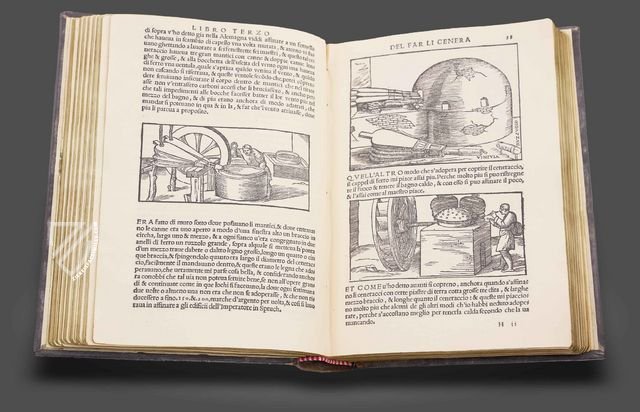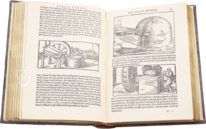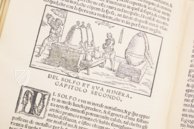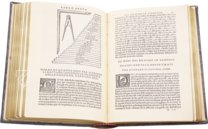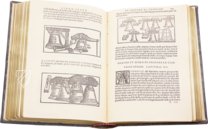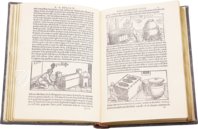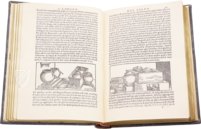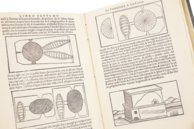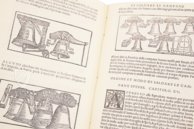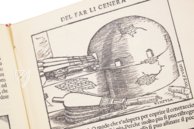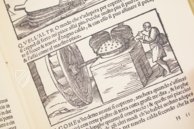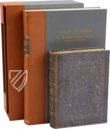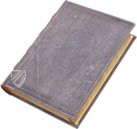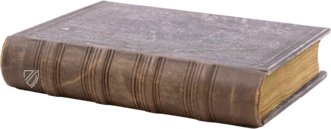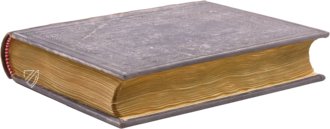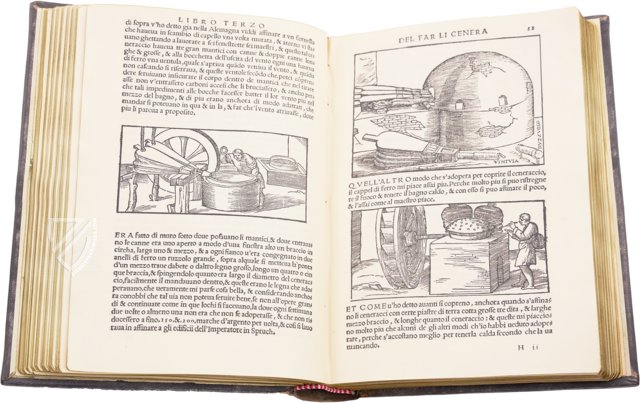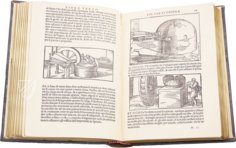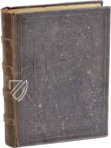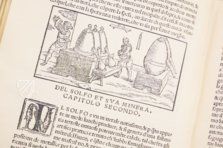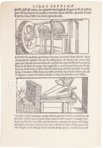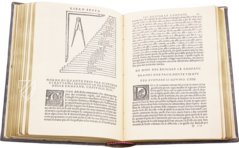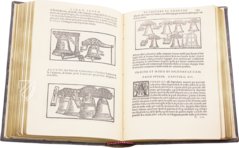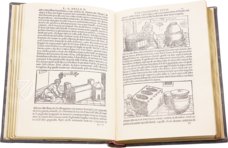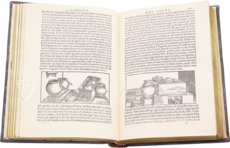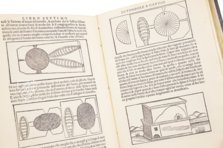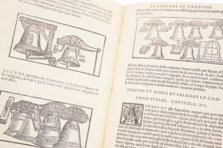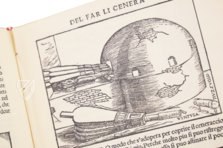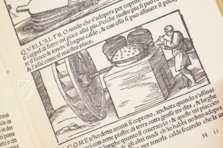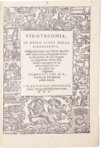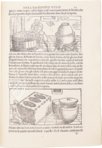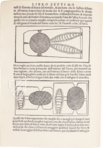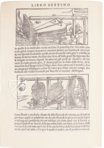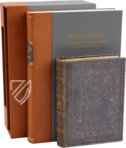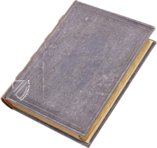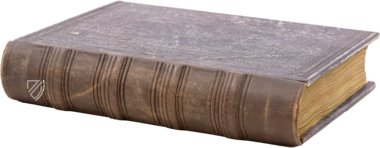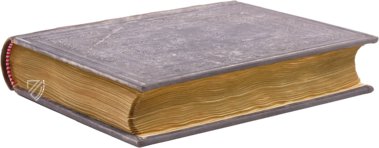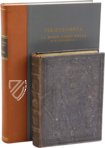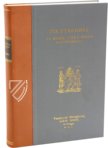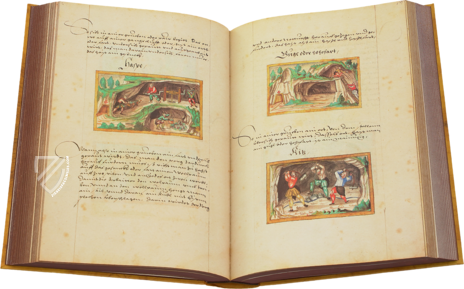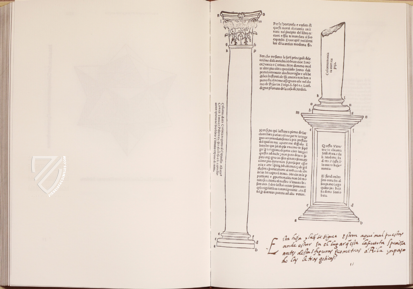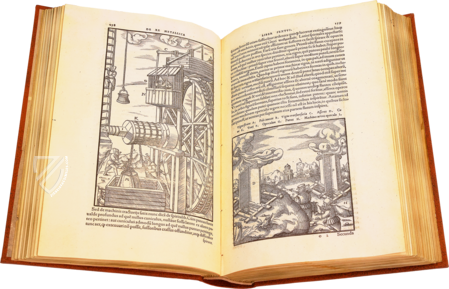De la Pirotechnia - Second Edition
(1,000€ - 3,000€)
De la Pirotechnia was the world’s first treatise on mining and metallurgy and constitutes one of the first technical manuals. It was written by the Italian metallurgist Vannoccio Biringuccio (ca. 1480 – ca. 1539), who was closely connected with the Petrucci family who ruled his native Siena at the time. Biringuccio’s treatise, whose title translates into English as “Of the Art of Fire”, was published posthumously in Venice in 1540, enjoying such success that the printer issued a second edition in 1550, and a third in 1559, which was published under the shortened title Pirotechnia. The second edition, presented here, is identical to the first in terms of format, structure, engravings, and initials. Various processes and technological principles are explained with the aid of 84 detailed, highly accurate engravings.
De la Pirotechnia - Second Edition
The first printed book concerning metallurgy was written by Vannoccio Biringuccio (ca. 1480 – ca. 1539), an Italian metallurgist from the Tuscan city of Siena. Biringuccio’s treatise was published posthumously in Venice in 1540, enjoying such success that the printer issued a second edition in 1550, and a third in 1559, which was published under the shortened title Pirotechnia. The work was translated into English in the 20th century by Cyril Stanley Smith (1903–1992), a British metallurgist, historian of science, and a senior chemist on the Manhattan Project. “Of the Art of Fire” is the world’s first treatise on mining and metallurgy and constitutes one of the first technical manuals. Biringuccio assembled knowledge accumulated across centuries and combined it with his own personal experience as a metallurgist. Various processes and technological principles are explained with the aid of 84 detailed, highly accurate engravings. The second edition, presented here, is identical to the first in terms of format, structure, engravings, and initials. The book was acquired inter alia at auction from the library of Honorato Juan, Bishop of Osma (d. 1566) by express mandate of King Philip II (1527–98) in the year 1567. The work is bound in embossed greenish gray calf leather and has been lovingly preserved for 500 years in the Royal Library of El Escorial Monastery.
A Renaissance Metallurgist
Biringuccio was born in Siena and baptized on October 20th, 1480, son of Paolo Biringuccio and Lucrecia di Bartolomeo. His father, an architect, was superintendent of the urban and architectural works of Siena, being closely linked to the Petrucci family, the lords of this city. With the support of Pandolfo Petrucci (1452–1512), Biringuccio began working at the Bocchenggiano iron mine, and later in the Monte Avanzo silver mine in Carnia. During the years 1507–1508 he traveled through Italy and Germany, visiting the great mining centers, observing and experimenting with everything related to metallurgy, foundries and even alchemy. After Pandolfo Petrucci died in 1512, his son Borghese appointed Biringuccio operator of the communal Armory in 1513, and in the following year he was awarded the right to run the Sienese mint for five years. A 1515 uprising forced Biringuccio to flee Siena along with the ruling Petrucci family, going first to Rome, then Naples, and finally to Sicily in 1517. Biringuccio returned to Siena in 1523 along with Fabio Petrucci, who assumed government of the city. In 1524 he was granted a monopoly on the production of saltpeter across all of Siena. During another rising two years later on July 25th, 1526, he directed the artillery in the siege of his hometown and in the assault on the Camolia gate specifically, but the Petrucci’s efforts were ultimately unsuccessful. He went on to travel through Germany, and came to serve the Republic of Florence. He returned to Siena in 1530, working as an architect on the Duomo. At the request of Pope Paul III (1468–1549), he returned to Rome in 1536, where he died unexpectedly in the following year.
The Art of Fire in Ten Books
Pirotechnia is constituted by ten books subdivided into chapters:
BOOK I. General rules for discovering metallic minerals, techniques for digging mines, and the necessary instruments. Refutes the claims of alchemy concerning the transmutation of metals.
BOOK II. Semi-minerals, glass, gems, and the manufacture of glass.
BOOK III. The fusion of metals and how to separate them.
BOOK IV. The separation and purification of gold and silver.
BOOK V. Gold, silver, copper, lead and tin alloys.
BOOK VI. Large bronze foundries for artillery pieces and bells.
BOOK VII. Various types of furnace used in the melting of metals, production of firearms.
BOOK VIII. The art of “piccola del gitto”, i.e. the casting of small artistic objects.
BOOK IX. Distillation, “alchimicha art”, pottery, preparation of brick and mortar, goldsmithing, iron forging, coin minting, and the manufacture of metal mirrors.
BOOK X. The manufacture of gunpowder, explosives, and fireworks.
Codicology
- Alternative Titles
- De la Pirotechnia - Zweite Ausgabe
- Size / Format
- 334 pages / 19.7 × 14.5 cm
- Origin
- Italy
- Date
- 1550
- Epochs
- Style
- Language
- Illustrations
- 84 large illustrative xylographs and various decorative initials
- Artist / School
- Vannoccio Biringucci (author, artist of the illustrated part of the first edition)
Giovanni Padoano (publisher)
De la Pirotechnia - Second Edition
Waterwheel and Bellows
As medieval metallurgy advanced, smiths required higher and higher temperatures. Waterwheels were used to power the bellows in blast furnaces, which first appeared in Scandinavia ca. 1100. They were primarily used for creating cast iron, which had many applications ranging from simple tools to doors, canons, and even entire bridges. Alloying elements such as carbon and silicon can be added to the glowing molten iron to change its properties. Furthermore, a water wheel never grows tired and eliminates the need for unskilled laborers to work the bellows.
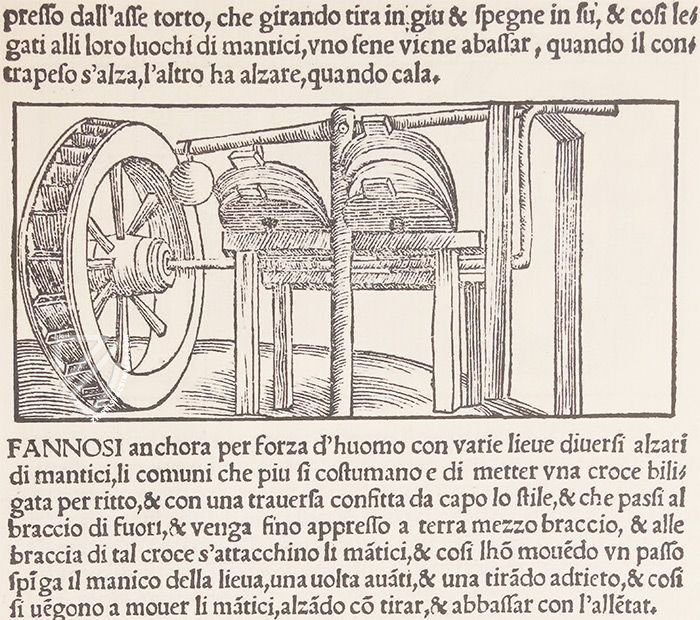
De la Pirotechnia - Second Edition
Title Page
The long and elaborate full title of the work is presented on this wonderfully decorated page with countless metallurgical instruments and creations as well as heraldic elements including a lion with a banderole in the bas-de-page and a crowned female figure at the top of the page named VENETIA. Holding a pair of scales, she appears to be sitting on a pair of lions between a sailing ship and a suit of classically styled armor.
The rest of the woodcut border shows the various applications of “pyrotechnics” for mining, smelting, and various other commercial enterprises. Some of the objects include hand tools, a wheelbarrow, bells, copper stills for distillation, cannons, and an anvil. This wonderfully detailed and diverse collection of objects related to metallurgy is a celebration of all that medieval smiths were able to accomplish.
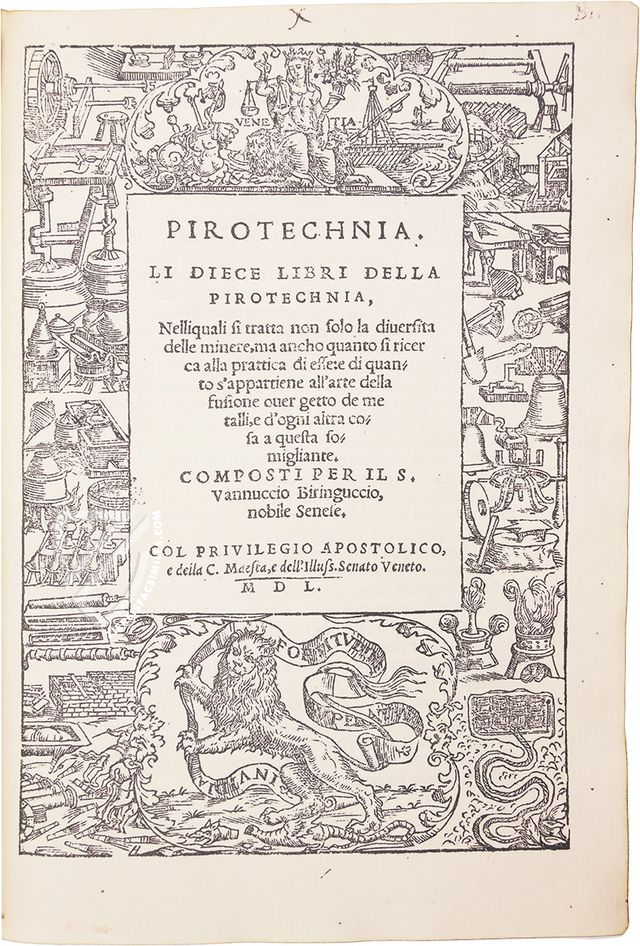
#1 De la Pirotechnia
Language: Spanish
(1,000€ - 3,000€)
- Treatises / Secular Books
- Apocalypses / Beatus
- Astronomy / Astrology
- Bestiaries
- Bibles / Gospels
- Chronicles / History / Law
- Geography / Maps
- Saints' Lives
- Islam / Oriental
- Judaism / Hebrew
- Single Leaf Collections
- Leonardo da Vinci
- Literature / Poetry
- Liturgical Manuscripts
- Medicine / Botany / Alchemy
- Music
- Mythology / Prophecies
- Psalters
- Other Religious Books
- Games / Hunting
- Private Devotion Books
- Other Genres
- Afghanistan
- Armenia
- Austria
- Belgium
- Belize
- Bosnia and Herzegovina
- China
- Colombia
- Costa Rica
- Croatia
- Cyprus
- Czech Republic
- Denmark
- Egypt
- El Salvador
- Ethiopia
- France
- Germany
- Greece
- Guatemala
- Honduras
- Hungary
- India
- Iran
- Iraq
- Israel
- Italy
- Japan
- Jordan
- Kazakhstan
- Kyrgyzstan
- Lebanon
- Liechtenstein
- Luxembourg
- Mexico
- Morocco
- Netherlands
- Palestine
- Panama
- Peru
- Poland
- Portugal
- Romania
- Russia
- Serbia
- Spain
- Sri Lanka
- Sweden
- Switzerland
- Syria
- Tajikistan
- Turkey
- Turkmenistan
- Ukraine
- United Kingdom
- United States
- Uzbekistan
- Vatican City
- A. Oosthoek, van Holkema & Warendorf
- Aboca Museum
- Ajuntament de Valencia
- Akademie Verlag
- Akademische Druck- u. Verlagsanstalt (ADEVA)
- Aldo Ausilio Editore - Bottega d’Erasmo
- Alecto Historical Editions
- Alkuin Verlag
- Almqvist & Wiksell
- Amilcare Pizzi
- Andreas & Andreas Verlagsbuchhandlung
- Archa 90
- Archiv Verlag
- Archivi Edizioni
- Arnold Verlag
- ARS
- Ars Magna
- ArtCodex
- AyN Ediciones
- Azimuth Editions
- Badenia Verlag
- Bärenreiter-Verlag
- Belser Verlag
- Belser Verlag / WK Wertkontor
- Benziger Verlag
- Bernardinum Wydawnictwo
- BiblioGemma
- Biblioteca Apostolica Vaticana (Vaticanstadt, Vaticanstadt)
- Bibliotheca Palatina Faksimile Verlag
- Bibliotheca Rara
- Boydell & Brewer
- Bramante Edizioni
- Bredius Genootschap
- Brepols Publishers
- British Library
- C. Weckesser
- Caixa Catalunya
- Canesi
- CAPSA, Ars Scriptoria
- Caratzas Brothers, Publishers
- Carus Verlag
- Casamassima Libri
- Centrum Cartographie Verlag GmbH
- Chavane Verlag
- Christian Brandstätter Verlag
- Circulo Cientifico
- Club Bibliófilo Versol
- Club du Livre
- CM Editores
- Collegium Graphicum
- Collezione Apocrifa Da Vinci
- Comissão Nacional para as Comemorações dos Descobrimentos Portugueses
- Coron Verlag
- Corvina
- CTHS
- D. S. Brewer
- Damon
- De Agostini/UTET
- De Nederlandsche Boekhandel
- De Schutter
- Deuschle & Stemmle
- Deutscher Verlag für Kunstwissenschaft
- DIAMM
- Droz
- E. Schreiber Graphische Kunstanstalten
- Ediciones Boreal
- Ediciones Grial
- Ediclube
- Edições Inapa
- Edilan
- Editalia
- Edition Deuschle
- Edition Georg Popp
- Edition Leipzig
- Edition Libri Illustri
- Editiones Reales Sitios S. L.
- Éditions de l'Oiseau Lyre
- Editions Medicina Rara
- Editorial Casariego
- Editorial Mintzoa
- Editrice Antenore
- Editrice Velar
- Edizioni Edison
- Egeria, S.L.
- Eikon Editores
- Electa
- Emery Walker Limited
- Enciclopèdia Catalana
- Eos-Verlag
- Ephesus Publishing
- Ernst Battenberg
- Eugrammia Press
- Extraordinary Editions
- Fackelverlag
- Facsimila Art & Edition
- Facsimile Editions Ltd.
- Facsimilia Art & Edition Ebert KG
- Faksimile Verlag
- Feuermann Verlag
- Folger Shakespeare Library
- Franco Cosimo Panini Editore
- Friedrich Wittig Verlag
- Fundación Hullera Vasco-Leonesa
- G. Braziller
- Gabriele Mazzotta Editore
- Gebr. Mann Verlag
- Gesellschaft für graphische Industrie
- Getty Research Institute
- Giovanni Domenico de Rossi
- Giunti Editore
- Graffiti
- Grafica European Center of Fine Arts
- Guido Pressler
- Guillermo Blazquez
- Gustav Kiepenheuer
- H. N. Abrams
- Harrassowitz
- Harvard University Press
- Helikon
- Hendrickson Publishers
- Henning Oppermann
- Herder Verlag
- Hes & De Graaf Publishers
- Hoepli
- Holbein-Verlag
- Houghton Library
- Hugo Schmidt Verlag
- Idion Verlag
- Il Bulino, edizioni d'arte
- ILte
- Imago
- Insel Verlag
- Insel-Verlag Anton Kippenberger
- Instituto de Estudios Altoaragoneses
- Instituto Nacional de Antropología e Historia
- Introligatornia Budnik Jerzy
- Istituto dell'Enciclopedia Italiana - Treccani
- Istituto Ellenico di Studi Bizantini e Postbizantini
- Istituto Geografico De Agostini
- Istituto Poligrafico e Zecca dello Stato
- Italarte Art Establishments
- Jan Thorbecke Verlag
- Johnson Reprint Corporation
- Josef Stocker
- Josef Stocker-Schmid
- Jugoslavija
- Karl W. Hiersemann
- Kasper Straube
- Kaydeda Ediciones
- Kindler Verlag / Coron Verlag
- Kodansha International Ltd.
- Konrad Kölbl Verlag
- Kurt Wolff Verlag
- La Liberia dello Stato
- La Linea Editrice
- La Meta Editore
- Lambert Schneider
- Landeskreditbank Baden-Württemberg
- Leo S. Olschki
- Les Incunables
- Liber Artis
- Library of Congress
- Libreria Musicale Italiana
- Lichtdruck
- Lito Immagine Editore
- Lumen Artis
- Lund Humphries
- M. Moleiro Editor
- Maison des Sciences de l'homme et de la société de Poitiers
- Manuscriptum
- Martinus Nijhoff
- Maruzen-Yushodo Co. Ltd.
- MASA
- Massada Publishers
- McGraw-Hill
- Metropolitan Museum of Art
- Militos
- Millennium Liber
- Müller & Schindler
- Nahar - Stavit
- Nahar and Steimatzky
- National Library of Wales
- Neri Pozza
- Nova Charta
- Oceanum Verlag
- Odeon
- Orbis Mediaevalis
- Orbis Pictus
- Österreichische Staatsdruckerei
- Oxford University Press
- Pageant Books
- Parzellers Buchverlag
- Patrimonio Ediciones
- Pattloch Verlag
- PIAF
- Pieper Verlag
- Plon-Nourrit et cie
- Poligrafiche Bolis
- Presses Universitaires de Strasbourg
- Prestel Verlag
- Princeton University Press
- Prisma Verlag
- Priuli & Verlucca, editori
- Pro Sport Verlag
- Propyläen Verlag
- Pytheas Books
- Quaternio Verlag Luzern
- Reales Sitios
- Recht-Verlag
- Reichert Verlag
- Reichsdruckerei
- Reprint Verlag
- Riehn & Reusch
- Roberto Vattori Editore
- Rosenkilde and Bagger
- Roxburghe Club
- Salerno Editrice
- Saltellus Press
- Sandoz
- Sarajevo Svjetlost
- Schöck ArtPrint Kft.
- Schulsinger Brothers
- Scolar Press
- Scrinium
- Scripta Maneant
- Scriptorium
- Shazar
- Siloé, arte y bibliofilia
- SISMEL - Edizioni del Galluzzo
- Sociedad Mexicana de Antropología
- Société des Bibliophiles & Iconophiles de Belgique
- Soncin Publishing
- Sorli Ediciones
- Stainer and Bell
- Studer
- Styria Verlag
- Sumptibus Pragopress
- Szegedi Tudomànyegyetem
- Taberna Libraria
- Tarshish Books
- Taschen
- Tempus Libri
- Testimonio Compañía Editorial
- Thames and Hudson
- The Clear Vue Publishing Partnership Limited
- The Facsimile Codex
- The Folio Society
- The Marquess of Normanby
- The Richard III and Yorkist History Trust
- Tip.Le.Co
- TouchArt
- TREC Publishing House
- TRI Publishing Co.
- Trident Editore
- Tuliba Collection
- Typis Regiae Officinae Polygraphicae
- Union Verlag Berlin
- Universidad de Granada
- University of California Press
- University of Chicago Press
- Urs Graf
- Vallecchi
- Van Wijnen
- VCH, Acta Humaniora
- VDI Verlag
- VEB Deutscher Verlag für Musik
- Verlag Anton Pustet / Andreas Verlag
- Verlag Bibliophile Drucke Josef Stocker
- Verlag der Münchner Drucke
- Verlag für Regionalgeschichte
- Verlag Styria
- Vicent Garcia Editores
- W. Turnowski Ltd.
- W. Turnowsky
- Waanders Printers
- Wiener Mechitharisten-Congregation (Wien, Österreich)
- Wissenschaftliche Buchgesellschaft
- Wissenschaftliche Verlagsgesellschaft
- Wydawnictwo Dolnoslaskie
- Xuntanza Editorial
- Zakład Narodowy
- Zollikofer AG

